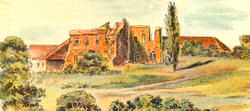Gostynin Parish Pictures
The following are pictures from the Gostynin Parish. Click on the thumbnail view for an enlarged view of the picture.
 |
The painting to the left is a 19th century view of the Lutheran Church in Gostynin, Russian Poland. The artist is unkown. | |
The town authorities of Gostynin have established a foundation for the purpose of restoration or reconstruction of the old Castle of Gostynin. The castle dates back to the end of the 14th century. In the course of time it was used for many purposes, in the beginning it was the seat of the local government and was visited by several Polish kings. Some decades later it also served as a prison, and the most prominent prisoners were the Russian czar Vassyli Szujski and his brothers Dymitri and Ivan in 1611. The castle was often reconstructed, but after the second half of the 17th century the castle fell into ruin. In 1824 the government donated the ruins to the Lutheran parishioners of Gostynin, who built the Lutheran church on the site of the castle, in part making use of the remaining walls. [According to Eduard Kneifel the building costs amounted to 3,513 Rubels, of which the government paid two thirds, while the rest was paid by the parishioners.] The church was used by the Roman-Catholic community until 1978, after which time it apparently was allowed to fall into ruin again. The reconstruction plans have been made by Ryszard Piosik, a well-known architect from Plock. It is one of the objectives of the foundation that the reconstructed castle will become the main tourist attraction of Gostynin, housing a conference center, hotel, and gastronomic restaurants. However, the foundation does not have sufficient financial means to embark on such a huge task on its own. Therefore, the foundation asks for financial aid from the citizens of Gostynin, as well as from countrymen who are now living in other parts of Poland or abroad. The above is a rough translation (courtesy of Jan Textor) of text from the Gostynin Castle Restoration Web Page (page no longer exists). Kniefel commentary not in original text. |
||
 |
Former Lutheran Church at Gostynin, still in ruins. - photo courtesy Miles Ertmann |
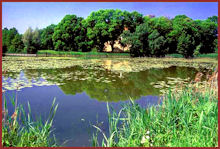 |
The church is on a small hill next to this lake on the outskirts of Gostynin town. - photo courtesy Miles Ertmann |
 |
Gostynin town hall. - photo courtesy Mike McHenry |
||
 |
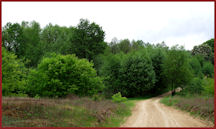 |
There are still a few houses along this sandy road at Budy Lucienski north of Gostynin but nothing that looks like a village. - photo courtesy of Jerry Frank |
|
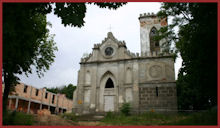 |
Church renovation underway. |
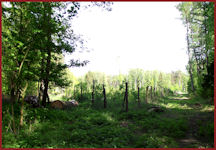 |
Mokro Niemieckie no longer exists and the location is now overgrown with trees and brush. The actual location was about 50m or so left of this clearing. - photo courtesy of Jerry Frank |
 |
Gostynin Church with extension as it exists today. The hotel part of the project did not proceed. - photo courtesy of Jerry Frank |
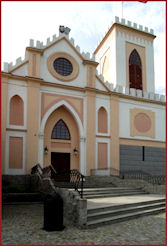 |
Renovated Gostynin church building. - photo courtesy Jerry Frank |
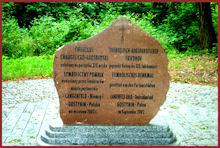 |
Evangelical Augsburg cemetery, founded in the early 19th century, Memorial Stone placed by the partnered towns of Langenfeld, Germany and Gostynin, Poland in September, 2002. - photo courtesy Frank Janke |
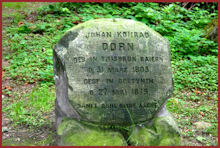 |
Gravestone of Johann Konrad Dorn, particularly well preserved. Bottom line reads, "May his ashes rest peacefully". (This stone was noted knocked off its base in 2012.) - photo courtesy Frank Janke |
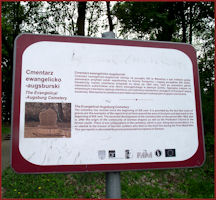 |
Efforts are being made to improve the look of the Lutheran cemetery in Gostynin but progress is slow. - photo courtesy of Jerry Frank |
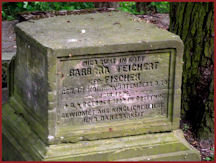 |
Stone marker for Barbara Teichert, nee Fischer, born 20 Jul 17?? in Wuerttemberg, died 4 Oct 1884 in Gostynin. - photo courtesy of Jerry Frank |
 |
Marker for Luise Arndt, nee Fritz, born 1868, died 1933. - photo courtesy of Jerry Frank |
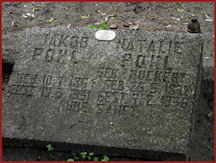 |
Marker for Jakob Pohl, b.1864, d.1931 and Natalie Pohl, b.1872, d.1936. - photo courtesy Jerry Frank |
Mokro Niemieckie In 2012, Jerry Frank, his son Rodney, and his brother Clarence attempted to find the village and cemetery. Correspondence and pictures from several years previous suggested that there were at least remnants of the cemetery in the forest. They parked at Biale on the southern edge of the forest and, armed with their old maps, walked in, using trails that at one time were the roads that led to several villages within the forest. After a 2 km walk, they were in the region of the village location. Searching for over an hour in that area on a very hot day in May provided no results. They found no signs of a former village or a cemetery. After returning home, Jerry managed to contact a German and Polish persons living in the Gostynin region who were interested in the local history of this area. They in turn contacted local forest rangers who helped them to find it. It turns out that it was only about 100 m from the area searched in May - less than a city block. The forest rangers arranged for the cemetery site to be cleared and the result can be seen below. Jutta Dennerlein, webmaster of the Upstream Vistula website later visited the site and shared some pictures with us. |
|||
 |
Many of the trails were still wide enough to accommodate a vehicle but in some places the bush was starting to overgrow them. |
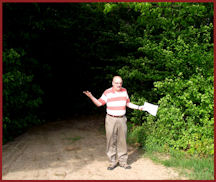 |
After our fruitless search. - photo courtesy of Jerry Frank |
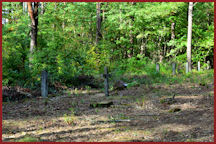 |
The cemetery as cleared by the rangers. Very few grave markers remain. This cross stands just in front of the remains of the bordering fence with concrete posts. - photo courtesy of Jutta Dennerlein |
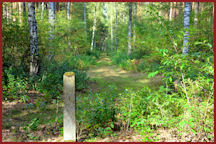 |
The road in and the cemetery gate are now more easily identified. - photo courtesy Jutta Dennerlein |
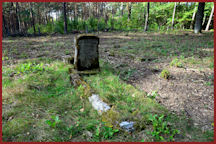 |
Some gravesites still remain, with marker in place. They are generally from after WW I. - photo courtesy of Jutta Dennerlein |
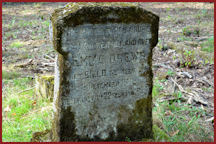 |
This marker identifies Emma Drews, nee Billo, born 2 Dec 1911, died 22 Feb 1934. - photo courtesy Jutta Dennerlein |

